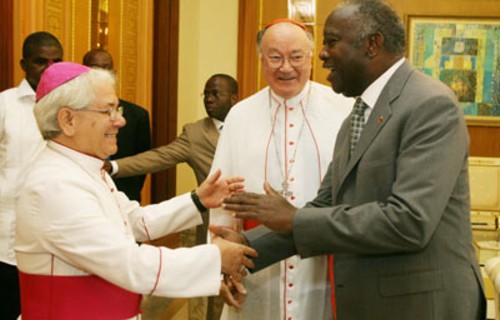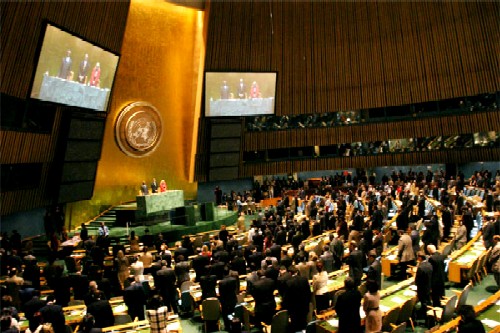Day: July 20, 2007
Papal Diplomacy – God’s Ambassadors

The job of representing the pope in Burundi brings with it a fine colonial villa, but nobody would say Archbishop Paul Gallagher has an enviable post. In 2003 his predecessor, Archbishop Michael Courtney, died in a hail of bullets after mystery attackers ambushed his car. Whoever they were, the killers were clear about their target: the vehicle bore diplomatic plates and a Vatican flag, while the Irish cleric, in white cassock and purple skull cap, was known to all; so was his role in negotiating a peace accord, sealed a month earlier. The day of his death, December 29th, is now a fixture in Burundi’s calendar.
Thousands of miles away, on the frontier between Argentina and Chile, papal diplomacy is remembered in a different way. A mountain pass has been renamed after Cardinal Antonio Samorè, who before his death in 1983 helped settle a territorial dispute that could have led to war. In different ways, the Irish archbishop and the Italian cardinal represent the best of an ancient and often contentious quirk of the international scene: the fact that the Roman Catholic church, alone among faiths, is a diplomatic player.
Over the past century—despite the march of secularism—the Vatican’s role in world affairs has expanded. In 1890 a famous English Catholic, Cardinal Manning, said the Holy See’s diplomatic activities were “a mere pageant”, a medieval relic. He would be amazed to find that in 2007 papal diplomacy is more active than ever.
The real explosion came under John Paul II. When he was elected in 1978, the Holy See had full ties with 85 states. When he died, the figure was 174. Among states that dropped their misgivings were Margaret Thatcher’s Britain, Ronald Reagan’s America and Mikhail Gorbachev’s Soviet Union. The Holy See now has full diplomatic relations with 176 states. Vietnam, China and Saudi Arabia are among the few without formal links. Recent years have also seen an expansion in the See’s multilateral diplomacy. It sits in on the deliberations of 16 inter-governmental bodies, including the United Nations, the African Union and the Organisation of American States.

The Vatican acts, by its own choice, as a “permanent observer” rather than a voting member of the UN; but it is a signatory to some UN human-rights conventions, including those on racial equality and the rights of the child. It uses these vantage points to lobby for its ideas: non-violence, a better economic deal for poor nations, the extension of international law, support for marriage—and, controversially, the “sanctity of life” from the time of conception, which means opposing contraception, abortion and euthanasia.
Arguments over the Holy See’s diplomatic status came to a head in 1994 when the pope’s envoys—lining up with Muslim states—used their muscle to water down the outcome of a UN meeting on population in Cairo. The Vatican took a similar, albeit slightly lower-key, stance at a follow-up conference in 1999. This prompted campaigners for “reproductive rights” to demand that the Vatican be stripped of its diplomatic status—arguing that neither as a state, nor as a religion, should the Holy See have a place at the UN.
The pope’s “diplomatic service” is a reminder of his unique and ambiguous status as both a religious and temporal leader. Formally, the pope’s diplomats represent the Holy See—not the Vatican state which, under a 1929 accord with Italy, is the sovereign power in part of Rome. But in years past, some states (such as America in the 19th century) would deal with the pope only as head of a sovereign state. The fact that pontiffs wear two hats, temporal and spiritual, gives them, and their interlocutors, a certain flexibility. In 2001, when Greece’s Orthodox clergy grumbled over a visit by Pope John Paul II, the government in Athens could retort that it was merely receiving him as a head of state.
But more and more governments have in recent years seemed happy to deal with the Holy See on its own terms, especially after John Paul II boosted its global profile. For any state, an embassy to the See offers attractions. For poor ones, it is a chance to garner information from one of the world’s best-informed chancelleries. For powerful ones, it offers a way to influence the Vatican and seek papal approval. Napoleon told his man in Rome: “Deal with the pope as if he had 200,000 men at his command.” After some years in Rome, the envoy said 500,000 was nearer the mark.
The real extent of the Vatican’s power is hard to compute. One in every six human beings was baptised into the pope’s church. Of course, many quit the faith, but he remains a global opinion-former. His views can sway Catholic votes—a point not lost on American presidents, who rarely miss a chance to visit the Vatican. In Burundi all top politicians and expatriates flock to Archbishop Gallagher’s residence for the papal feast day. Cutting a lower profile than his predecessor, the 53-year-old Englishman reports only “occasional” contacts with Burundi’s rebel factions, the last of which signed a ceasefire agreement in September 2006. In the rich world one respecter of papal clout is Britain’s new prime minister, Gordon Brown. Three years ago this son of a Presbyterian minister went to seek Vatican endorsement of a proposal to boost aid to poor nations. This year he returned to co-launch a plan to bring new vaccines to poor states.
